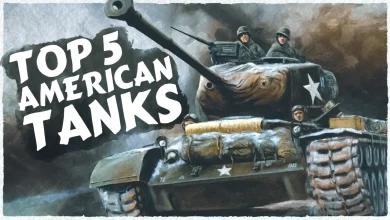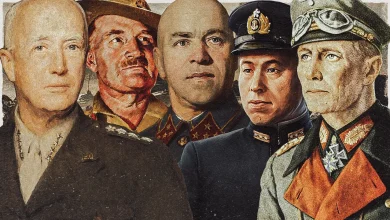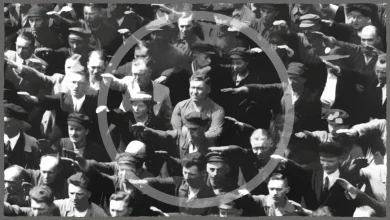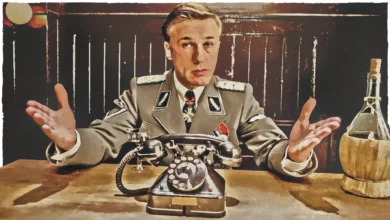Operation Barbarossa Begins
The master of 9 European capitals… ruler of Europe from the Arctic Coldness of the North Cape to the warm island beaches of Crete, his armies unbeaten even further south the frontier of Egypt, Hitler had now set his sights and his armies on Moscow.
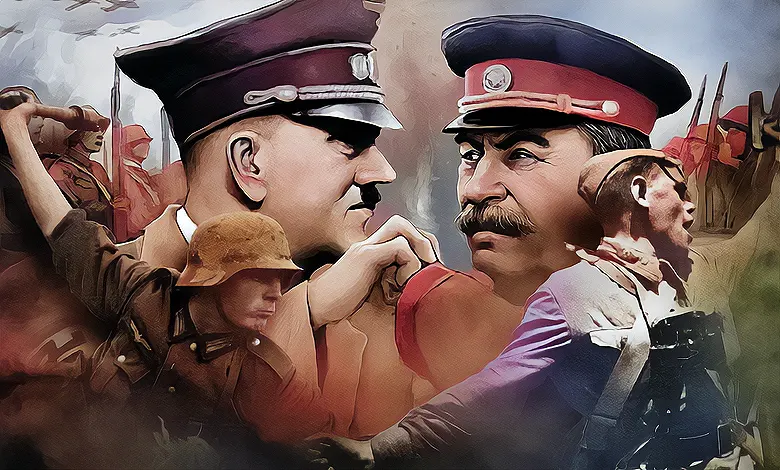
June 22, 1941, Operation Barbarossa begins. This Operation is the German invasion of the Soviet Union, and they are invading with the largest invasion force in the history of warfare.
In the early morning of the 21st, a submarine commander in the Soviet Red Navy reports the sighting of a convoy of 32 German troop transports at the entrance to the Gulf of Finland. That evening, General Maksim Purkayev phones Red Army Chief of Staff Georgy Zhukov to tell him that a German Sergeant-Major has come to the Soviet border guards and is telling them that the German troops are at their jumping off areas and they will attack in the morning.
That deserting soldier’s name, by the way, is Alfred Liskof, a dedicated communist who swims across the Bug River to warn the Soviets. Well, Purkayev calls Zhukov, and he calls Josef Stalin and then Stalin and Zhukov meet Defense Commissar Semyon Timoshenko at the Kremlin. Stalin says that the Germans may have sent this “turncoat” to provoke a conflict. Timoshenko nixes this and tells Joe that the Germans have also cut the telephone lines into the Soviet Union, and they really need to alert all their troops in the border districts. Stalin says that it’s too early for that, but does agree to a directive to the Military Councils in the border districts warning them that a sudden German attack might happen, but he adds that they should not be incited by any provocations made by the Germans. That directive goes out just after midnight.

Alfred Liskow was a German soldier and deserter who swam across the Bug River at 9:00 pm on the eve of Operation Barbarossa near Sokal, just north of Lwow, in 1941 to warn the Red Army of imminent attack the next morning
What else is going on that night? A few stories from that night courtesy of Martin Gilbert. Adolf Hitler is with Albert Speer and Erich Raeder. After dinner, he speaks of his plans for building a German naval base near Trondheim, Norway- the biggest dockyards in the Reich! And they would build a city there too for 250,000 Germans to live in. Hitler puts on the gramophone and plays his guests Franz Liszt’s “les Preludes”, telling them they should get used to hearing it, because it’s going to be the victory fanfare for Barbarossa.
Adolf Hitler with Albert Speer, Hitler’s architect, who became Minister of Armaments and War Production in World War II

He also talks of his plans for building huge monumental buildings in Berlin and other German cities- those plans, he said, are now sealed in blood. Because Russia will be the source of granite and marble in any quantities they should want. At Novgorod-Volynsk, Soviet General Konstantin Rokossovsky is guest of honor at a concert at his HQ, and when he gets the Moscow Directive, he orders his commanders to go to their units…. after the concert. General Dmitry Pavlov in Kiev is watching a comedy, and when he gets the word, he chooses to see the show to its end. In Siemiatycze, there is a ball in progress the evening of the 21st, and the attendees include, as they often do at such functions there, the German border patrol from the other side of the border as well as many people from the local Jewish population. The ball is still in full swinging progress past 4 AM when bombs begin falling and the power goes out. Despite all the build ups of men and materiel, and all the foreshadowing and everything, the Soviets are taken by nearly total surprise.
The Germans have 140 of their own divisions and their allies and co-belligerents will throw in more. This all includes 17 panzer divisions and 13 motorized ones. So far during the war, the losses the Wehrmacht has taken are pretty tiny by 20th century war numbers- especially compared to WW1 figures. They’ve lost some 70,000 men killed or missing in Poland, Denmark, Belgium, the Netherlands, France, Luxembourg, Yugoslavia, Greece, North Africa and Crete combined. The army has grown in size from 3.7 million men to 5 million, the Luftwaffe to 1.7 million, the Kriegsmarine to 400,000, and even the Waffen SS from 50k to 150k. “…the German army, with the air fleets which supported it, was not only larger but disproportionally stronger in every way- in weapons, in reserves, but above all in operational skill- than in 1939. Hitler’s rearmament program of 1935-39 had merely lent military weight to his adventures in foreign policy; his war making had permeated the whole of German society. One German male in four was now in uniform; most had directly experienced victory, had trodden the soil of occupied territory and had seen soldiers of the victor nations of 1918 taken into captivity. The red white black and swastika flag had been raised “from the Meuse to the Memel, from the Belt to the Adige” as the national anthem proclaimed it should fly, and German soldiers now stood ready to carry it even deeper into the zone of conquest Hitler had worked out as his own: into Stalin’s Russia.”
Here is the German roll call on June 22nd from north to south: Army Group North, under FM Wilhelm von Leeb is 26 divisions.

These are in two armies- the 18th under Georg von Kuchler and the 16th under Ernst Busch. Erich Hoepner’s 4th Panzer Group is there in 3 panzer divisions. One army division is in reserve and three are earmarked as security forces. They are supported by Luftflotte I.
Army Group Center, the largest force, is led by FM Fedor von Bock- this is 51 divisions.

There are two Panzer Groups, the 3rd under Hermann Hoth and the 2nd under Heinz Guderian, in 9 total panzer divisions. The two infantry armies are the 9th under Adolf Strauss and the 4th under Hans Gunther von Kluge. They have two reserve divisions and support from Luftflotte II.
Army Group South is 41 German divisions under FM Gerd von Rundstedt.

They have one Panzer Group, group Ewald von Kleist, with five divisions. Three armies are here, the 6th under Walther von Reichenau, the 17th under Carl-Heinrich von Stulpnägel, and the 11th under Eugen von Schobert. They are backed with three reserve divisions and Luftflotte IV.
They also have 14 Romanian divisions in the Romanian 3rd and 4th armies, under Petre Dumitrescu and Nicolae Ciuperca respectively.

In the far north, preparing to soon join the festivities, are Niklaus von Falkenhorst’s units in occupied Norway

and 21 divisions of the Finnish Army who are looking forward to taking back all the land that they were forced to cede to the Soviet Union last year after the Winter War.

Altogether, this is some 3.5 million men, with some 7,100 artillery pieces and 3,300 tanks. Now, this is more tanks and about the same number of big guns used last year in France, but it’s also over a much larger area. There is a larger proportion of Mark III and IV tanks than last year, around 1,400 of them now, but Hitler’s desire to give them better guns has still not happened. The actual panzer divisions themselves now are organized differently- there are more of them, but with smaller numbers in each. The largest has 199 units compared with 300 last year. There are now also 250 assault guns and they’re with infantry support battalions, but they’re under the control of the artillery, not the armor, so they’re actually competing for resources and production.
The Soviet Red Army side is under the direction of Zhukov and Timoshenko. The men in the field along the battlefront from north to south are deployed as follows: Fyodor Kuznetsov’s Northwest Front.

24 divisions including 4 tank divisions in two armies, the 8th under Pyotr Sobennikov and the 11th under Vasili Morosov.
Then Pavlov’s Western Front, 38 divisions strong, including 8 tank divisions.

This is the 3rd Army under Vassily Kuznetsov, the 10th Army under Konstantin Golubev, and the 4th under Alexander Korobkov. The 13th under Pyotr Filatov is in reserve at Minsk.
The 56 divisions on the SW Front, including 16 tank divisions, are under Mikhail Kirponos, and are comprised of the 5th army under M.I. Potapov, the 6th under Ivan Muzychenko, the 26th under Fyodor Kostenko, and the 12th under Pavel Ponedelin.

And down toward the Black Sea is the Southern Front under Ivan Tyulenev. 16 divisions including 4 tank divisions in Ilya Smirnov’s 18th Army and Yakov Cherevichenko’s 9th.

Looking at things like logistics and resources, both sides have issues right from the start. A big issue facing the Germans is how to traverse the hundreds and hundreds of kilometers they’ll have to cover to achieve their objectives, over land with few roads and a railroad system that uses a different gauge. They’ve assembled as large a motor pool as they can, using not only German vehicles, but many from France and other occupied nations, which in itself will unavoidably cause problems with maintenance and spare parts.

So the Germans are also using 635,000 horses to launch this invasion, meaning that some their units are very mobile and can forge ahead, and some move at foot and horse speed. There’s the danger that the first will advance beyond the point where they can keep effective contact.

The Soviets have a lot of men and a lot of stuff, and that’s great for them, but if you look at it closer, there are big flaws. They have a total army strength of 230 divisions, but of that, only like 170 are in the western part of the whole Soviet Union, and moving the ones there not at the front to the front is a move still in many cases of over 1,000 km, and it’s several thousand kilometers for the 60 divisions in the rest of the country.
They have a lot more total tanks than the Germans do, around 24,000 of them. But, only around a quarter of them are in actual running combat order. German intelligence estimates the Red Army to have 10,000 total, so they’re way underestimating them. Also, the Soviets have two new model tanks, the T-34 and the KV-1. 1,475 of these are now with the Soviet tank divisions, and the Germans don’t really know anything about these models, or what they might be capable of in the field.

The Red Air Force has the numbers advantage as well- some 8,000 planes. However, many of these are in a poor state of repair, and a lot of them are obsolete. 1941 Red Army Purge got rid of a lot of the senior and junior officers of the army, and the men who’ve replaced them are not necessarily men of any great military competence. After the Winter War exposed a lot of weaknesses in the Red Army, they did make some big changes, but it’s been only a year and there hasn’t really been time for training. Some of the tank drivers have literally only operated a tank for a total of an hour. And this gigantic attack comes as such a surprise that some of the units that are supposed to be at the front lines are over 300 km away in barracks, some are on training grounds, and some at the front lines are too far forward.
The initial German plan is for Leeb to head toward Leningrad, Bock for Smolensk, and Rundstedt for Kiev.

Hitler has also called for Bock to turn north and aid army group north after Smolensk. German Army Chief of Staff Franz Halder, however, has plans for Bock to drive on to Moscow, so we’ll have to see how that situation develops.

03:15 on June, 22nd Operation Barbarossa begins with artillery bombardment, then an advance by motorized units, then the Luftwaffe hit the skies at first light. It is one year to the day since France surrendered.
German Propaganda Minister Joseph Goebbels reads a proclamation live over the radio written by Adolf Hitler.

“Weighed down with heavy cares, condemned to months of silence, I can at last speak freely- German people! At this moment a march is taking place that, for its extent, compares with the greatest the world has ever seen. I have decided again today to place the fate and future of the Reich and our people in the hands of our soldiers. May God aid us especially in this fight.” A few minutes after Goebbel’s radio address, Zhukov issues orders to the Red Army to attack and destroy the invader wherever he crosses the border, but to not themselves to cross the border into the Reich. Soviet FM Vyacheslav Molotov is to broadcast to the nation at noon. Before that, though, the Soviets ask Japan to act as intermediaries for a diplomatic solution, but when it becomes clear that there is to be no such thing, then comes the announcement that the USSR has been invaded and is at war.
